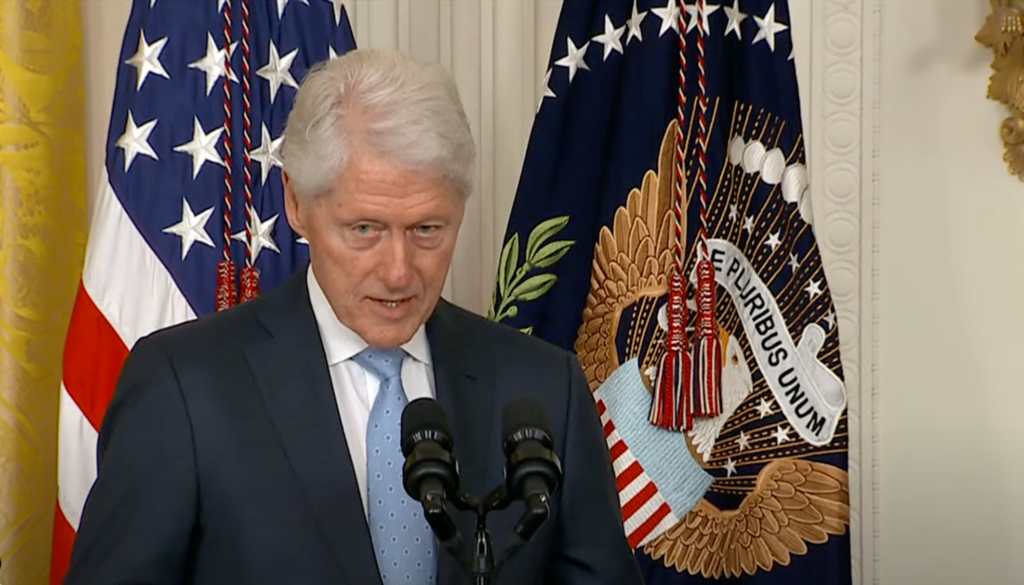Bill Clinton's Bold Take: Could A Republican Woman Be America's First Female President?

Here's the scoop: The idea that America might elect its first female president from the Republican Party has sparked quite the conversation. During a recent interview, former President Bill Clinton shared his thoughts, shedding light on how cultural and political shifts could impact the path to the White House for women. This isn’t just politics—it’s a fascinating look at how gender dynamics intersect with party lines. Stick around as we dive deeper into why Clinton thinks a Republican woman might have an edge in breaking the ultimate glass ceiling.
For those of us who love to stay in the loop with celebrity, entertainment, and breaking news, this is a must-read. Let’s explore what it takes to make history in U.S. politics and how we can all play a part in shaping the future.
Table of Contents
Read also:Patrick J Adams Net Worth 2024 Journey To Success
- Why Did Bill Clinton Suggest the US Would Elect a Female Republican President First?
- The Challenges Faced by Female Democratic Candidates in US Elections
- Republican Women and Their Perceived Advantage in Presidential Races
- The Role of Cultural and Political Shifts in Gender Bias
- The Future of Women in US Presidential Politics
- Comparing the 2024 Election Outcomes for Kamala Harris and Nikki Haley
- Key Steps Toward Electing the First Female President
- Conclusion
Why Did Bill Clinton Suggest the US Would Elect a Female Republican President First?
Let’s face it: Bill Clinton knows a thing or two about U.S. politics. When he suggested that a Republican woman might be the first to break the ultimate glass ceiling, he wasn’t pulling it out of thin air. His reasoning? A shift in cultural dynamics that’s tilting the nation further to the right. This trend, according to Clinton, could create a more welcoming environment for a conservative woman to lead the country.
Now, this isn’t about undermining the efforts of Democratic women—it’s about acknowledging the unique challenges they face. Clinton’s insight highlights how deeply intertwined cultural and political shifts are with gender bias. It’s a complex web, and understanding it is key to making progress toward equality in leadership.
The Challenges Faced by Female Democratic Candidates in US Elections
Take Kamala Harris and Hillary Clinton, for example. Both trailblazers in their own right, they’ve faced uphill battles that underscore the resistance women in leadership roles often encounter. Here’s a closer look:
- Kamala Harris: As the first female Vice President, Harris made history. But her loss to Donald Trump in the 2024 election revealed the deep-seated challenges female Democratic leaders face. It wasn’t just about her policies—it was about the biases that still linger in our society.
- Hillary Clinton: Her 2016 run was another pivotal moment in the fight for gender equality. Despite her vast experience and qualifications, she faced an uphill battle that highlighted the persistent biases against women in leadership roles.
It’s important to recognize that these setbacks don’t define the progress that’s been made. Both Harris and Clinton have paved the way for future generations, proving that persistence and advocacy are essential ingredients in the fight for gender equality.

Republican Women and Their Perceived Advantage in Presidential Races
On the flip side, Republican women like Nikki Haley might have an easier path to the presidency. Clinton pointed out that their alignment with values that resonate with traditionalist voters gives them a unique advantage, especially in today’s politically polarized climate.
Read also:Anthony Edwards Net Worth 2024 Journey From Er To Film Success And Beyond
Haley’s journey in the 2024 primaries is a prime example. Though she eventually suspended her campaign to support Trump, her rise demonstrated how Republican women can navigate gender barriers differently. By leveraging party support and appealing to conservative voters, they can strengthen their bids for leadership.
Clinton’s comments suggest that a Republican woman could capitalize on the current sociopolitical landscape, achieving what Democratic women have been striving for decades. It’s a complex dynamic, but one worth exploring as we move closer to breaking barriers.
The Role of Cultural and Political Shifts in Gender Bias
Gender bias remains a formidable obstacle in U.S. elections. Clinton noted that “cultural battles” complicate efforts to elect female leaders, particularly for Democrats. In a politically polarized environment, voters often view women candidates through the lens of their party affiliation rather than their qualifications.
Consider this: Republican women might find more traction in conservative-leaning states where cultural norms align with their party’s principles. Meanwhile, Democratic women face a tougher road, as their progressive policies often clash with traditionalist views. It’s a balancing act that requires not only strong leadership but also a shift in societal attitudes.
Stay updated on important news events in our breaking news section.
The Future of Women in US Presidential Politics
Despite the hurdles, Clinton remains optimistic about the future. He believes it’s only a matter of time before the U.S. elects its first female president. This milestone, however, will require a combination of societal changes and robust support for women candidates across party lines.
Leaders like Harris, Clinton, and Haley have all contributed to this progress, inspiring younger generations to pursue leadership roles. As Clinton put it, the journey is challenging, but the destination is within reach. Bipartisan efforts and shifts in societal attitudes will be crucial in making this vision a reality.

Exploring Richard Roundtree's Net Worth In 2024: The Journey Of A Legendary Actor
Darren Aronofsky’s Journey: Net Worth, Major Film Successes, And Earnings Growth In 2024
Tami Roman's Net Worth In 2024: The Story Behind Her Success


